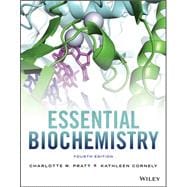Essential Biochemistry, 4th Edition is comprised of biology, pre-med and allied health topics and presents a broad, but not overwhelming, base of biochemical coverage that focuses on the chemistry behind the biology. Furthermore, it relates the chemical concepts that scaffold the biology of biochemistry, providing practical knowledge as well as many problem-solving opportunities to hone skills. Key Concepts and Concept Review features help students to identify and review important takeaways in each section.








